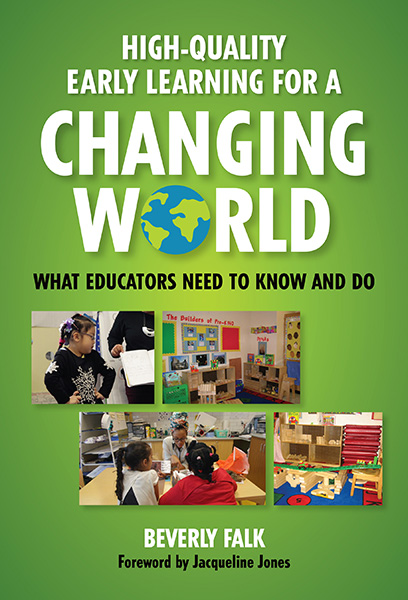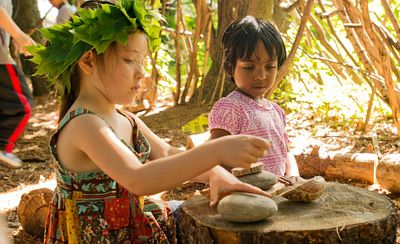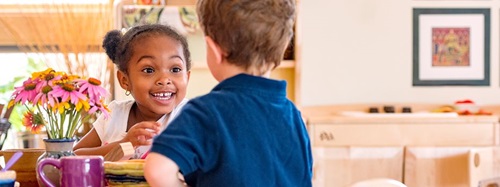Provisioning the Environment:
Supporting High Quality Early Learning
| September 2019The launch of a new school year offers an opportunity to assess/reassess how our classrooms are set up to support children’s learning. Because research informs us that experience is the trigger that enables children to organize their brains to support the challenges they meet, and because we know that these experiences support the development of the whole child—social, emotional, cultural, linguistic, physical, and cognitive—a positive learning environment for young children needs to provide activities for all of these aspects of growth.
To do this, the classroom needs to include activity centers that offer opportunities for both hands-on, play-based learning and developmentally appropriate instruction of academic skills. A rich array of materials needs to be available in areas/centers that invite children to inquire, explore, discover, and engage with each other about ideas. Varied types of activities need to be offered throughout the day and provided in a clear and predictable schedule, supported by routines and carefully planned transitions that result in a smooth and well-managed flow of the day.
The Physical Environment Supports Active Learning
The physical arrangement of the classroom should be guided by the goal of supporting children to develop the skills of thinking, reasoning, problem-solving, decision-making, applying understandings to new contexts, and expressing ideas and sharing them with others. These 21st-century learning goals are supported by a classroom arranged into different interest areas or centers that provide opportunities for learning in all of the disciplines—literacy, mathematics, the sciences, and the arts. A wide variety of materials need to be available and accessible to all. In this kind of an environment children can test and express their ideas, make decisions, solve problems, apply their own reasoning to diverse situations, and share their learning experiences with others.
The classroom areas/centers need to be clearly defined, each housing a variety of materials for children to use as tools for disciplinary and cross-disciplinary learning. Tables and chairs and/or spaces for individual and small-group work should be available in each area. One large area should be designated as a space for the whole class to gather for meetings. Display spaces for children’s work, at their eye level, and storage space for the children’s belongings, are also staples of classrooms that support high-quality learning for young children.
Activity Areas and Materials Support Disciplinary and Cross-Disciplinary Learning
Some of the basic activity centers/areas of a high-quality early learning environment that fosters children’s abilities to construct knowledge and understandings are:
Block Center
A block area that houses a full set of wooden unit blocks arranged by size and shape in low open shelving that clearly demarcates where each block should be stored;
Math/Manipulative Center
A math/manipulative area that offers a variety of materials including puzzles, small blocks, Legos, games, tiles, geoboards, attribute blocks, and other hands-on materials that foster children’s thinking and problem-solving skills and support the development of the big ideas of math that are appropriate for young children (counting and cardinality, operations and algebraic thinking, number and number sense, measurement and data, and geometry);
Library Center
A library area that contains a variety of books arranged by areas of interest and difficulty level—all of which should span the full range of readers who live in the classroom;
Writing Center
A writing/drawing area that provides different types of paper, writing/drawing materials (crayons, markers, pencils), stamps, stencils, alphabet charts, and so on, and that can be combined with art materials (for younger children) or separated into its own area as children become more advanced on the literacy development continuum;
Art Center
An art area that offers different types of paper and drawing materials (crayons, markers, etc.), as well as paste or glue, scissors, stamps, watercolors, pastels, and tempera paints and brushes, an easel or table available for large painting, collage and construction materials, and other assorted materials such as playdough and clay;
Science Center
A science area that includes magnifying glass(es), sand/water table, animals (guinea pigs, snails, mealworms, etc.), and other items from the natural world (such as plants, rocks, shells, leaves, etc.), depending on the time of the year, curriculum topic, or interests of the children in the classroom. Within this area, children should be given time to experiment with measuring, counting, pouring, and making predictions;
Dramatic Play Center
A dramatic play area for younger children (at least through kindergarten) that can be used as a “house” or set up to relive and reflect the ideas and understandings of the particular curriculum focus of the class (i.e., post office, train station, doctor’s office, etc.);
Media Center
A media center that provides access to computers, audio equipment, a smartboard, and other technology;
Cooking Center
A cooking area that contains the tools necessary for preparing snacks or other foods related to the curriculum;
Meeting Area
A large meeting area big enough to accommodate the whole class gathering together for group discussions, lessons, stories, and music/movement activities. It can be in one of the areas of the classroom—such as the block area or the library—that serves a dual purpose;
Outdoor Area
An outdoor play area—if possible, connected directly to the classroom—where children can run, jump, climb, play with wheel toys, grow a garden, and engage in other physical activities.
These activity centers will often include materials that promote many different kinds of learning. The purposes that they serve overlap, nurturing learning in a variety of disciplines. For example, language and literacy are supported everywhere and throughout the day, but especially in the block area (through talking, writing signs, etc.), the writing center, the dramatic play area, the library, and the media center. Social studies are especially supported in the areas for blocks, library, cooking, dramatic play, and science. Math development is featured in the centers involving blocks, construction, woodworking, science, manipulatives, and math. Learning in the arts takes place in the art area, the dramatic play area, and the space for music/movement. Science is supported in the areas designated for blocks, cooking, dramatic play, math, plants, and animals
Some of these areas are or can be subdivisions of another area—such as a separate table just for playdough, an area just for construction (of recyclable materials such as cartons, cereal boxes, paper towel and toilet paper rolls, etc.), an area for sewing, and so on. And sometimes these areas will be emphasized more in one grade or developmental level over another. Regardless of age and developmental stage, however, all learners need meaningful, purposeful contexts to help them make sense of new knowledge and to learn needed skills.
Arranging Activity Centers
When deciding on the location of each area in the classroom, consider keeping activities that are related or complementary and that have similar noise levels and equipment needs near each other. For example, areas that require access to water (such as art and science) should be near each other (and near a sink). Areas that are noisier and complementary (i.e., blocks and dramatic play area) should be adjacent. Quiet areas such as library, media, and writing should be close. Traffic patterns within the classroom should also be considered so that children engaged in related work have materials nearby to support them (i.e., construction area near the art area, or writing area near the library, etc.) or so that quiet areas are not interrupted with the flow of traffic.
Each area should be defined by boundaries that separate them from the other areas. The boundary markers can be low storage shelves, bulletin boards, or even tables and chairs. These boundaries should mark the location of an area in the classroom’s organizational scheme without inhibiting children’s activity.
Storing Materials to Support Children’s Autonomy
To promote children’s independence, autonomy, and sense of self-efficacy, materials housed in the centers should be accessible for children so that they can get what they need on their own. This means that shelving should be open and reachable by small hands. Labels should be posted at each spot where the materials belong, giving children a guide for where to find and return the materials while promoting their literacy development (seeing the written words for the things they need).
Changing Materials to Support Interest and Active Learning
Because we know that interest is a motivator for learning and that active experiences are an important way that young children learn, it is important that classroom centers/areas be provisioned with materials that hold children’s interest, are multifaceted, and are culturally/linguistically/developmentally appropriate. For example, a math area should offer objects with which children can experiment and manipulate (teddy bear counters, stirrers for bundling when learning base, etc.). A dramatic play area can be stocked with realistic food objects and food containers.
Active involvement is key to maintaining interest. Children will return to an area again and again when it contains materials that can be used in a variety of ways and at different levels of complexity. Regularly changing the materials in an area helps to maintain children’s interest and involvement.
Limited materials should be placed in the areas at the beginning of the school year, with a gradual introduction of more and more complex materials throughout the year. Children first need to be acclimated to how to handle materials before they can sort through and use them productively. As the curriculum and children’s skills evolve and the interests of the children evolve, new materials can be introduced into different areas reflecting the topics of study. For example, the dramatic play area can be a home, a train station, or a doctor’s office depending on the focus of the curriculum.
In a classroom set up for active learning, richly provisioned centers/areas play a prominent role in the children’s learning. The teacher is the facilitator, not the center of activity. To enable this, teachers need to carefully plan out the environment and children’s experiences, intentionally place relevant materials in classroom centers, observe children carefully while they are at work, and follow up on children’s questions, issues, misunderstandings, or interests that are noticed throughout the day. In these ways, teachers can facilitate learning relevant to real-life experiences and that reflect the interests and understandings of the class.
Read more from Dr. Falk's book: High-Quality Early Learning for a Changing World















